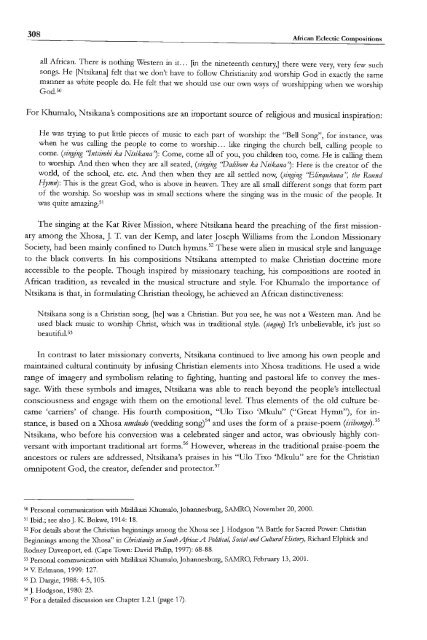South African Choral Music (Amakwaya): Song, Contest and the ...
South African Choral Music (Amakwaya): Song, Contest and the ...
South African Choral Music (Amakwaya): Song, Contest and the ...
You also want an ePaper? Increase the reach of your titles
YUMPU automatically turns print PDFs into web optimized ePapers that Google loves.
308 <strong>African</strong> Eclectic Compositions<br />
all <strong>African</strong>. There is nothing Western in it... [in <strong>the</strong> nineteenth century,] <strong>the</strong>re were very, very few such<br />
songs. He [Ntsikana] felt that we don't have to follow Christianity <strong>and</strong> worship God in exactly <strong>the</strong> same<br />
manner as white people do. He felt that we should use our own ways of worshipping when we worship<br />
God. 50<br />
For Khumalo, Ntsikana's compositions are an important source of religious <strong>and</strong> musical inspiration:<br />
He was trying to put little pieces of music to each part of worship: <strong>the</strong> ''Bell <strong>Song</strong>", for instance, was<br />
when he was calling <strong>the</strong> people to come to worship... like ringing <strong>the</strong> church bell, calling people to<br />
come. (singing ''Intsimbi ka Ntsikana'): Come, come all of you, you children too, come. He is calling <strong>the</strong>m<br />
to worship. And <strong>the</strong>n when <strong>the</strong>y are all seated, (singing 'Valibom ka Nsikana'): Here is <strong>the</strong> creator of <strong>the</strong><br />
world, of <strong>the</strong> school, etc. etc. And <strong>the</strong>n when <strong>the</strong>y are all settled now, (singing ''Elinqukuva '; <strong>the</strong> Round<br />
Hymn): This is <strong>the</strong> great God, who is above in heaven. They are all small different songs that form part<br />
of <strong>the</strong> worship. So worship was in small sections where <strong>the</strong> singing was in <strong>the</strong> music of <strong>the</strong> people. It<br />
was quite amazing. 51<br />
The singing at <strong>the</strong> Kat River Mission, where Ntsikana heard <strong>the</strong> preaching of <strong>the</strong> first mission<br />
ary among <strong>the</strong> Xhosa, J. T. van der Kemp, <strong>and</strong> later Joseph Williams from <strong>the</strong> London Missionary<br />
Society, had been mainly confined to Dutch hymns.52 These were alien in musical style <strong>and</strong> language<br />
to <strong>the</strong> black converts. In his compositions Ntsikana attempted to make Christian doctrine more<br />
accessible to <strong>the</strong> people. Though inspired by missionary teaching, his compositions are rooted in<br />
<strong>African</strong> tradition, as revealed in <strong>the</strong> musical structure <strong>and</strong> style. For Khumalo <strong>the</strong> importance of<br />
Ntsikana is that, in formulating Christian <strong>the</strong>ology, he achieved an <strong>African</strong> distinctiveness:<br />
Ntsikana song is a Christian song, [he] was a Christian. But you see, he was not a Western man. And he<br />
used black music to worship Christ, which was in traditional style. (singiniJ It's unbelievable, it's just so<br />
beautifu1. 53<br />
In contrast to later missionary converts, Ntsikana continued to live among his own people <strong>and</strong><br />
maintained cultural continuity by infusing Christian elements into Xhosa traditions. He used a wide<br />
range of imagery <strong>and</strong> symbolism relating to fighting, hunting <strong>and</strong> pastoral life to convey <strong>the</strong> mes<br />
sage. With <strong>the</strong>se symbols <strong>and</strong> images, Ntsikana was able to reach beyond <strong>the</strong> people's intellectual<br />
consciousness <strong>and</strong> engage with <strong>the</strong>m on <strong>the</strong> emotional level. Thus elements of <strong>the</strong> old culture became<br />
'carriers' of change. His fourth composition, "Ulo Tixo 'Mkulu" ("Great Hymn"), for instance,<br />
is based on a Xhosa umdudo (wedding song)54 <strong>and</strong> uses <strong>the</strong> form of a praise-poem (isibongo).55<br />
N tsikana, who before his conversion was a celebrated singer <strong>and</strong> actor, was obviously highly con<br />
versant with important traditional art forms. 56 However, whereas in <strong>the</strong> traditional praise-poem <strong>the</strong><br />
ancestors or rulers are addressed, Ntsikana's praises in his "Ulo Tixo 'Mkulu" are for <strong>the</strong> Christian<br />
omnipotent God, <strong>the</strong> creator, defender <strong>and</strong> protector.57<br />
50 Personal communication with Mzilikazi Khumalo,Johannesburg, SAMRO, November 20, 2000.<br />
51 Ibid.; see also J. K. Bokwe, 1914: 18.<br />
52 For details about <strong>the</strong> Christian beginnings among <strong>the</strong> Xhosa see J. Hodgson "A Battle for Sacred Power: Christian<br />
Beginnings among <strong>the</strong> Xhosa" in Christianity in <strong>South</strong> Africa: A Political, Social <strong>and</strong> Cultural History, Richard Elphick <strong>and</strong><br />
Rodney Davenport, ed. (Cape Town: David Philip, 1997): 68-88.<br />
53 Personal communication with lVIzilikazi Khumalo, Johannesburg, SAMRO, February 13, 2001.<br />
54 V Erlmann, 1999: 127.<br />
55 D. Dargie, 1988: 4-5, 105.<br />
56 J. Hodgson, 1980: 23.<br />
57 For a detailed discussion see Chapter 1.2.1 (page 17).

















